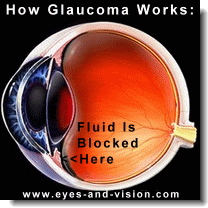
Open Angle Glaucoma:
The most common form of glaucoma is open-angle, or chronic simple glaucoma. It runs in families but does not hit very member of the family. Sometimes it skips one or even several generations. It's called open-angle because, although it looks as if there is no reason why the fluid cannot drain out of the eyes properly, it can't. The blockage seems to be caused by an increased resistance to
The most common form of glaucoma is open-angle, or chronic simple glaucoma. It runs in families but does not hit very member of the family. Sometimes it skips one or even several generations. It's called open-angle because, although it looks as if there is no reason why the fluid cannot drain out of the eyes properly, it can't. The blockage seems to be caused by an increased resistance to
Angle Closure Glaucoma:
Angle closure glaucoma, also known as narrow-angle glaucoma, accounts for less than 5 percent of all glaucoma. But when it does strike, it strikes fast. It occurs when the outflow of fluid is suddenly blocked, which causes a quick fluid backup and a rapid and dangerous climb in intraocular pressure. It is an emergency condition. A patient can experience severe eye pain, blurred vision, colored halos around lights, nausea, and vomiting. Unless the pressure is relieved within a few hours, the patient can be permanently blinded. Pilocarpine drops are frequently used to immediately relieve the pressure, after which surgery is performed to permanently solve the problem.
Angle closure glaucoma, also known as narrow-angle glaucoma, accounts for less than 5 percent of all glaucoma. But when it does strike, it strikes fast. It occurs when the outflow of fluid is suddenly blocked, which causes a quick fluid backup and a rapid and dangerous climb in intraocular pressure. It is an emergency condition. A patient can experience severe eye pain, blurred vision, colored halos around lights, nausea, and vomiting. Unless the pressure is relieved within a few hours, the patient can be permanently blinded. Pilocarpine drops are frequently used to immediately relieve the pressure, after which surgery is performed to permanently solve the problem.
Congenital Glaucoma:
Congenital glaucoma is the principal form of glaucoma to hit children. Most of these cases are diagnosed during the first year of life. This form of glaucoma is caused by a congenital abnormality of the filtration angle. It may also accompany other abnormalities. The earliest and most constant symptom is watery eyes. The corneas may appear hazy, and the child may be very sensitive to light. If the rise in pressure continues, the eyes can even increase in size. Congenital glaucoma must usually be treated by surgery. The earlier it is diagnosed and treated, the better the eyesight the child is left with.
Congenital glaucoma is the principal form of glaucoma to hit children. Most of these cases are diagnosed during the first year of life. This form of glaucoma is caused by a congenital abnormality of the filtration angle. It may also accompany other abnormalities. The earliest and most constant symptom is watery eyes. The corneas may appear hazy, and the child may be very sensitive to light. If the rise in pressure continues, the eyes can even increase in size. Congenital glaucoma must usually be treated by surgery. The earlier it is diagnosed and treated, the better the eyesight the child is left with.
Secondary Glaucoma:
Secondary glaucoma is a condition that can be a by-product of other eye problems, such as trauma. If you get hit in the eye, for example, the blow can damage the filtration angle so that fluid cannot properly drain out of the eye. Secondary glaucoma can sometimes develop after surgery, or it can be a side effect of using eyedrops containing corticosteroids. No one knows why steroid eyedrops cause some people to develop glaucoma, but it happens. So when they are being used, the eye pressure should be monitored carefully.
Secondary glaucoma is a condition that can be a by-product of other eye problems, such as trauma. If you get hit in the eye, for example, the blow can damage the filtration angle so that fluid cannot properly drain out of the eye. Secondary glaucoma can sometimes develop after surgery, or it can be a side effect of using eyedrops containing corticosteroids. No one knows why steroid eyedrops cause some people to develop glaucoma, but it happens. So when they are being used, the eye pressure should be monitored carefully.
With every form of glaucoma, constant vigilance is the best protection against this stealthy vision thief. Here are the different types of glaucoma you should watch for, especially after the age of thirty-five:
Neovascular Glaucoma:
Cases of neovascular glaucoma can occur in patients with diabetes. It develops because blood vessels may grow uncontrollably over the iris and obstruct the flow of fluid through the eye. Be sure to watch the diet and don't exercise too vigorously.
Cases of neovascular glaucoma can occur in patients with diabetes. It develops because blood vessels may grow uncontrollably over the iris and obstruct the flow of fluid through the eye. Be sure to watch the diet and don't exercise too vigorously.

the outflow of fluid within the trabecular meshwork. Why? No one knows yet. We do know that it usually affects both eyes, but the rise in pressure may be greater in one eye than in the other. See the page Glaucoma Treatments for information about cures for open-angle glaucoma.
Also See: Glaucoma:About Glaucoma Treatments
Types Of Glaucoma:
Contact Lenses | Glaucoma | Just For Fun | Eyeglasses | Eye Doctor | Eye Care And Symptoms | Eye Anatomy | Online Eye Tests | Laser Eye Surgery | Laser Eye Surgery Directory: Canada | Laser Eye Surgery Directory: USA | Laser Eye Surgery Reviews | Submit A Review | Contact Us | Privacy Policy | Sitemap
Copyright 2006-2009 Vision Health

